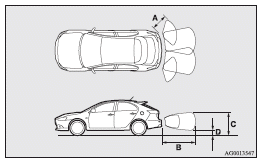Reversing sensor system detection areas
Depending on whether the vehicle is equipped with a towing bar, you can change the reversing sensor system between the standard mode and the towing bar mode. The towing bar mode changes the system to exclude the area in which the towing bar is mounted from the detection areas.
Vehicles without a towing bar
The detection areas are within approximately 60 cm (A) from the corner sensors, 150 cm (B) from the back sensors, and 60 cm (C) or less from the ground surface, excluding the area approximately 10 cm (D) from the ground surface.

Vehicles with a towing bar
The detection areas are within approximately 60 cm (A) from the corner sensors, 150 cm (B) from the back sensors, and 60 cm (C) or less from the ground surface, excluding the area approximately 10 cm (D) from the ground surface. The non-detection areas (E) are within approximately 20 cm (F) from the bumper.

![]() Note
Note
► If the rear bumper has been exposed to an impact, the corner or back sensors
may fail and prevent the system from functioning properly.
Have the vehicle inspected at a MITSUBISHI MOTORS Authorized Service Point.
► The sensors do not detect objects located in the area directly below or near the
bumper. If the height of an object is lower than the mounted position of the corner
or back sensors, the sensors may not continue detecting it even if they detected
it initially.
For information on how to change the detection areas, please refer to “Changing the detection areas”.
![]() Caution
Caution
► The reversing sensor system may not operate properly under the following
conditions:
• The sensors or surroundings are covered with ice, snow, or mud.
• The sensors are frozen.
• The system receives ultrasonic noise from other sources (the horns of other vehicles,
motorcycle engines, brakes, radios, pouring rain, splashing water, tyre chains,
etc.).
• The sensors are extremely hot or cold (while the vehicle is parked for a long
period of time under a blazing sun or in cold weather).
• The vehicle tilts significantly.
• The vehicle is driven on a rough road (with a bumpy, gravel, hilly, or grassy
surface).
• The vehicle is too close to an obstacle.
• The sensors or surroundings have been wiped by hand, or stickers or accessories
have been attached.
► The reversing sensor system may not properly detect the following:
• Objects that are thin, such as wire nets or ropes.
• Objects that absorb sound waves, such as snow.
• Objects that are shaped with a sharp angle.
• Objects with a smooth surface, such as glass.
• Objects that are low, such as kerbstones.
![]() Note
Note
► The buzzer may sound lower than the normal warning sound when the reversing sensor system is receiving ultrasonic noise from other sources, but this is not a malfunction. The buzzer will stop sounding and the system will return to normal operation after the noise is no longer received.
See also:
Fusible links
The fusible links will melt to prevent a fire if a large current attempts to
flow through certain electrical systems.
In case of a melted fusible link, we recommend you to have your vehicle inspect ...
Cigarette lighter
The cigarette lighter can be used while the ignition switch is in either “ON”
or “ACC”.
1- Push all the way in.
The lighter will automatically return to its original position with a “c ...
Front room & map lamps
When replacing the bulb, put the front room & map lamps switch into the “OFF”
position.
1. Insert a straight blade (or minus) screwdriver with a cloth over its tip into
the notch of the l ...
